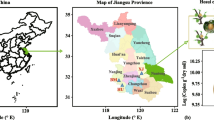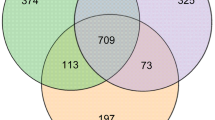Abstract
A study was conducted in Michigan (MI) to assess spatial patterns of soil biological and physiochemical factors related to yield in potato production. The project developed an approach to integrate techniques including: high-throughput DNA sequencing; GIS; geostatistics; traditional soil analyses; and yield data. Twenty soil samples were taken and GPS marked in the fall of 2012 from a grower’s field scheduled to be in potato production, and total genomic DNA was extracted. Parallel sequencing targeting the 16S rRNA gene was used to assess bacterial diversity. The total number of taxa identified by sequence analysis was 21, 81, 140, 300 and 814 at the level of phyla, class, order, family and genus respectively. Sequencing results and information gathered on yield at each point was used to generate multi-layer GIS-based maps.
Resumen
Se condujo un estudio en Michigan (MI) para evaluar los patrones espaciales de factores biológicos y fisioquímicos del suelo relacionados al rendimiento en la producción de papa. El proyecto desarrolló un planteamiento para integrar técnicas, incluyendo: secuenciación de ADN de alto rendimiento; GIS, geoestadística, análisis tradicional de suelo; y datos de rendimiento. Se tomaron 20 muestras y se marcaron con GPS en otoño de 2012 en un campo de un productor programado para ser de producción de papa, y se extrajo el ADN total genómico. Se usó secuenciación paralela del gen 16S del ARNr para evaluar la diversidad bacteriana. El número total de taxa identificado por el análisis de secuencia fue 21, 81, 140, 300 y 814 al nivel de phyla, clase, orden, familia y género respectivamente. Los resultados de la secuenciación y la información recopilada en rendimiento en cada punto, se usaron para generar mapas de multicapas basados en GIS.


Similar content being viewed by others
References
Acosta-Martinez, V., S. Dowd, Y. Sun, and V. Allen. 2008. Tag-encoded pyrosequencing analysis of bacterial diversity in a single soil type as affected by management and land use. Soil Biology and Biochemistry 40: 2762–2770.
Adrian, A.M., C. Dillard, and P. Mask. 2005. GIS in agriculture. Hershey PA: Idea Group Publishing.
Barnett, B.A., D.G. Holm, J.W. Koym, R.G. Wilson, and D.K. Manter. 2015. Site and clone effects on the potato root-associated core microbiome and its relationship to tuber yield and nutrients. American Journal of Potato Research 92: 1–9.
Buèe, M., M. Reich, C. Murat, E. Morin, R.H. Nilsson, S. Uroz, and F. Martin. 2009. 454 pyrosequencing analyses of forest soils reveal an unexpectedly high fungal diversity. New Phytologist 184: 449–456.
Caporaso, J.G., C.L. Lauber, W.A. Walters, D. Berg-Lyons, C.A. Lozupone, P.J. Turnbaugh, N. Fierer, and R. Knight. 2011. Global patterns of 16S rRNA diversity at a depth of millions of sequences per sample. Proceedings of the National Academy of Sciences 108: 4516–4522.
Caporaso, J.G., C.L. Lauber, W.A. Walters, D. Berg-Lyons, J. Huntley, N. Fierer, S.M. Owens, J. Betley, L. Fraser, and M. Bauer. 2012. Ultra-high-throughput microbial community analysis on the Illumina HiSeq and MiSeq platforms. The ISME Journal 6: 1621–1624.
Clark, I., Place, A. L. G., Oen, L. S., 1986. The art of cross validation in geostatistical applications. In Proceedings of the 19th International APCOM Symposium, Pennsylvania. State University, April, pp. 211–220.
Cole, J., Q. Wang, E. Cardenas, J. Fish, B. Chai, R. Farris, A. Kulam-Syed-Mohideen, D. McGarrell, T. Marsh, and G. Garrity. 2009. The ribosomal database project: improved alignments and new tools for rRNA analysis. Nucleic Acids Research 37: D141–D145.
Cole, J.R., Q. Wang, B. Chai, and J.M. Tiedje. 2011. The ribosomal database project: Sequences and software for high-throughput rRNA analysis. Hoboken, NJ: Wiley-Blackwell.
Costa, R., M. Götz, N. Mrotzek, J. Lottmann, G. Berg, and K. Smalla. 2006. Effects of site and plant species on rhizosphere community structure as revealed by molecular analysis of microbial guilds. FEMS Microbiology Ecology 56: 236–249.
Davis, B.M. 1987. Uses and abuses of cross-validation in geostatistics. Mathematical Geology 19: 241–248.
Dias, A.C.F., E.F. Hoogwout, M.d.C. Pereira e Silva, J.F.O. Salles, L.S. van Overbeek, and J.D. van Elsas. 2012. Potato cultivar type affects the structure of ammonia oxidizer communities in field soil under potato beyond the rhizosphere. Soil Biology and Biochemistry 50: 85–95.
El Sebai, T., B. Lagacherie, G. Soulas, and F. Martin-Laurent. 2007. Spatial variability of isoproturon mineralizing activity within an agricultural field: geostatistical analysis of simple physicochemical and microbiological soil parameters. Environmental Pollution 145: 680–690.
Garbeva, P., J. Van Elsas, and J. Van Veen. 2008. Rhizosphere microbial community and its response to plant species and soil history. Plant and Soil 302: 19–32.
González-Rodríguez, R.M., R. Rial-Otero, B. Cancho-Grande, and J. Simal-Gandara. 2008a. Determination of 23 pesticide residues in leafy vegetables using gas chromatography-ion trap mass spectrometry and analyte protectants. Journal of Chromatography A 1196: 100–109.
González-Rodríguez, R.M., R. Rial-Otero, B. Cancho-Grande, and J. Simal-Gandara. 2008b. Occurrence of fungicide and insecticide residues in trade samples of leafy vegetables. Food Chemistry 107: 1342–1347.
Goovaerts, P. 1997. Geostatistics for natural resources evaluation. New York, NY: Oxford University Press.
Heermann, D., J. Hoeting, S. Thompson, H. Duke, D. Westfall, G. Buchleiter, P. Westra, F. Peairs, and K. Fleming. 2002. Interdisciplinary irrigated precision farming research. Precision Agriculture 3: 47–61.
Huber, D. 1981. The use of fertilizers and organic amendments in the control of plant disease. In CRC Handbook of pest management in agriculture, 357–394. Boca Raton, FL: CRC Press.
Huber, D.M. and Arny, D.C. (1985). Interaction of potassium with plant disease. In Potassium in Agriculture, Ed. R.D. Munson. Madison, WI: American Society of Agronomy, pp. 467–488.
Huber, D.M., and R.D. Graham. 1999. The role of nutrition in crop resistance and tolerance to diseases. In Mineral nutrition of crops: fundamental mechanisms and implications, ed. Z. Rengel, 169–204. New York: Food Products.
Huse, S.M., J.A. Huber, H.G. Morrison, M.L. Sogin, and D.M. Welch. 2007. Accuracy and quality of massively parallel DNA pyrosequencing. Genome Biology 8: R143.
Huse, S., L. Dethlefsen, J. Huber, D. Welch, D. Relman, and M. Sogin. 2008. Exploring microbial diversity and taxonomy using SSU rRNA hypervariable tag sequencing. PLoS Genetics 4: e1000255.
Jones, R.T., M.S. Robeson, C.L. Lauber, M. Hamady, R. Knight, and N. Fierer. 2009. A comprehensive survey of soil acidobacterial diversity using pyrosequencing and clone library analyses. The ISME Journal 3: 442–453.
Kozich, J.J., S.L. Westcott, N.T. Baxter, S.K. Highlander, and P.D. Schloss. 2013. Development of a dual-index sequencing strategy and curation pipeline for analyzing amplicon sequence data on the MiSeq Illumina sequencing platform. Applied and Environmental Microbiology 79: 5112–5120.
Lambert, D.H., M.L. Powelson, and W.R. Stevenson. 2005. Nutritional interactions influencing diseases of potato. American Journal of Potato Research 82: 309–319.
Larkin, R.P., and T.S. Griffin. 2007. Control of soilborne potato diseases using Brassica green manures. Crop Protection 26: 1067–1077.
Lazarovits, G., J. Hill, G. Patterson, K.L. Conn, and N.S. Crump. 2007. Edaphic soil levels of mineral nutrients, pH, organic matter, and cationic exchange capacity in the geocaulosphere associated with potato common scab. Phytopathology 97: 1071–1082.
Lewis, J.A., and G. Papavizas. 1991. Biocontrol of plant diseases: the approach for tomorrow. Crop Protection 10: 95–105.
Liu, Z.Z., T.Z. DeSantis, G.L. Andersen, and R. Knight. 2008. Accurate taxonomy assignments from 16S rRNA sequences produced by highly parallel pyrosequencers. Nucleic Acids Research 36: e120.
Lucas, J.A. 1998. Plant pathology and plant pathogens. United Kingdom: Blackwell Science Ltd..
Mazzola, M. 2002. Mechanisms of natural soil suppressiveness to soilborne diseases. Antonie Van Leeuwenhoek 81: 557–564.
Miller, J., B. Hopkins, and D. Johnson. 2008. Checklist for a holistic potato health management plan. In Potato health management, ed. D. Johnson, 7–10. St. Paul, MN: APS Press.
O’Sullivan, D., and D.J. Unwin. 2003. Geographic information analysis. Hoboken, N.J: Wiley.
Paulitz, T.C., and R.R. Bélanger. 2001. Biological control in greenhouse systems. Annual Review of Phytopathology 39: 103–133.
Rogerson, P.A. 2010. Statistical methods for geography: A student’s guide. London, UK: SAGE.
Rosenzweig, N. 2014. The importance and application of bacterial diversity in sustainable agricultural crop production ecosystems. In Bacterial diversity in sustainable agriculture, ed. D. K. Maheshwari, 341–367. Cham, CH: Springer.
Rosenzweig, N., J. Tiedje, J.I. Quensen, Q. Meng, and J. Hao. 2012. Microbial communities associated with potato common scab suppressive soil determined by pyrosequencing analyses. Plant Disease 96: 718–725.
Schisler, D.A., P.J. Slininger, R.W. Behle, and M.A. Jackson. 2004. Formulation of Bacillus spp. for biological control of plant diseases. Phytopathology 94: 1267–1271.
Schloss, P.D., S.L. Westcott, T. Ryabin, J.R. Hall, M. Hartmann, E.B. Hollister, R.A. Lesniewski, B.B. Oakley, D.H. Parks, C.J. Robinson, J.W. Sahl, B. Stres, G.G. Thallinger, D.J. Van Horn, and C.F. Weber. 2009. Introducing mothur: open source, platform-independent, community-supported software for describing and comparing microbial communities. Applied and Environmental Microbiology 75: 7537–7754.
Smalla, K., G. Wieland, A. Buchner, A. Zock, J. Parzy, S. Kaiser, N. Roskot, H. Heuer, and G. Berg. 2001. Bulk and rhizosphere soil bacterial communities studied by denaturing gradient gel electrophoresis: plant-dependent enrichment and seasonal shifts revealed. Applied and Environmental Microbiology 67: 4742–4751.
Steere, L., N. Rosenzweig, and W. Kirk. 2016. Using conditional probability and a nonlinear kriging technique to predict potato early die caused by Verticllium dahliae. In Geographical information systems theory, applications and management, eds. C. Grueau and J.G. Rocha, 142–151. Cham, CH: Springer.
Stevenson, W., R. Loria, G. Franc, and D. Weingartner. 2001. Compendium of potato diseases. St. Paul: American Phytopathological Society.
Teixeira, L.C., R.S. Peixoto, J.C. Cury, W.J. Sul, V.H. Pellizari, J. Tiedje, and A.S. Rosado. 2010. Bacterial diversity in rhizosphere soil from Antarctic vascular plants of Admiralty Bay, maritime Antarctica. The ISME Journal 4: 989–1001.
Van Bruggen, A. 1995. Plant disease severity in high-input compared to reduced-input and organic farming systems. Plant Disease 79: 976–984.
Voelkerding, K.V., S.A. Dames, and J.D. Durtschi. 2009. Next-generation sequencing: from basic research to diagnostics. Clinical Chemistry 55: 641–658.
Weinert, N., Y. Piceno, G.C. Ding, R. Meincke, H. Heuer, G. Berg, M. Schloter, G. Andersen, and K. Smalla. 2011. PhyloChip hybridization uncovered an enormous bacterial diversity in the rhizosphere of different potato cultivars: many common and few cultivar-dependent taxa. FEMS Microbiology Ecology 75: 497–506.
Werner, J.J., D. Zhou, J.G. Caporaso, R. Knight, and L.T. Angenent. 2012. Comparison of Illumina paired-end and single-direction sequencing for microbial 16S rRNA gene amplicon surveys. ISME Journal-International Society for Microbial Ecology 6: 1273.
Yin, C., K.L. Jones, D.E. Peterson, K.A. Garrett, S.H. Hulbert, and T.C. Paulitz. 2010. Members of soil bacterial communities sensitive to tillage and crop rotation. Soil Biology and Biochemistry 42: 2111–2119.
Zhang, L., and Z. Xu. 2008. Assessing bacterial diversity in soil: a brief review. Journal of Soils and Sediments 8: 379–388.
Acknowledgments
This work was supported by the Michigan Potato Industry Commission though the USDA NIFA Specialty Crop Block Grant Program (Grant #791 N1300). Additional funding and resources were provided by the Michigan Potato Industry Commission and the Michigan State University Project GREEEN (Generating Research and Extension to Meet Economic and Environmental Needs).
Author information
Authors and Affiliations
Corresponding author
Ethics declarations
Declaration
The experiments comply with the current laws of the United States of America.
Additional information
N. Rosenzweig and L. Steere contributed equally.
Electronic Supplementary Material
Fig. S1
Soil types obtained through the Soil Survey Geographic database (SSURGO) made available from the Natural Resources Conservation Service (http://www.nrcs.usda.gov) and sampling points (n = 20) of study area. (DOC 301 kb)
Fig. S2
Principle component analysis summarizing relationships between abiotic and biotic soil parameters. (DOC 261 kb)
Fig. S3
Two contour maps generated from the sample points (n = 10) where yield was measured to predict yield values at any non-sampled point in the field using the Inverse Distance Weighting (IDW) method of interpolation (A) and the ordinary Kriging (B) method of interpolation. (DOC 55620 kb)
Rights and permissions
About this article
Cite this article
Rosenzweig, N., Steere, L., Gerondale, B. et al. A Geostatistical Approach to Visualize the Diversity of Soil Inhabiting Bacteria and Edaphic Qualities in Potato (Solanum tuberosum) Production Systems. Am. J. Potato Res. 93, 518–532 (2016). https://doi.org/10.1007/s12230-016-9530-8
Published:
Issue Date:
DOI: https://doi.org/10.1007/s12230-016-9530-8




